As you may have seen in my last post, lately I have been reviewing some of data we have from Tianwen-1. In the days following the landing of Zhurong, back in May, we had so much data in our hands that I couldn’t post about it in a timely manner. We were wondering if we could use this data to plan for a number of experiments with the 20 meter antenna at Bochum observatory. These included trying to receive data from the rover relayed by the orbiter, and trying to detect the rover’s direct X-band link to Earth. We didn’t manage to do any of these, unfortunately, as they had a great deal of luck involved.
During the summer I’ve been involved in several activities such as collaborating with the SETI Institute and BSRC REU summer student programmes by teaching some GNU Radio lessons, and preparing material for GRCon21 (a talk, a workshop and paper). Now I have more time at hand, so it’s good to revisit this data. In this post I’ll look at Tianwen-1’s orbit after the release of the lander.
On May 14, Tianwen-1 released the rover Zhurong on the surface of Mars. I reported the event in this blog post. After the collision avoidance burn, the orbiter still remained on orbit with a period of nearly 2 Mars sidereal days. This orbit had an apoapsis radius of 60970 km, a periapsis altitude of 442 km, an inclination of 89.2 deg, and argument of periapsis of 163.7 deg.
The periapsis of this orbit was passed on 2021-05-17 00:28:32 UTC. In this moment, Tianwen-1 made a manoeuvre to lower the apoapsis and pass to an orbit with a period of 1/3 of a Mars sidereal day. The first telemetry indicating this change that was received by AMSAT-DL with the 20 metre antenna at Bochum observatory corresponded to 2021-05-17 08:59:26 UTC (spacecraft time). By then, the spacecraft had already passed the first apoapsis of the new orbit, at around 08:40 UTC. According to the telemetry, the new orbit had a periapsis altitude of 266 km, so apparently a periapsis lowering burn was made at the 08:40 UTC apoapsis. The apoapsis radius was 16011 km, the argument of periapsis 175.6 deg (a slight change from the 2 day orbit), and the inclination was still 89.2 deg.
The purpose of this new orbit was to provide more frequent passes over the rover, so that the orbiter could be used as a communications relay. The change to this orbit was made at periapsis when the orbiter passed over the rover. As a consequence, every Mars sidereal day the orbiter would pass again on its periapsis over the rover, since the orbiter would have completed 3 revolutions, and Mars would have completed a revolution with respect to the inertial frame. The geometry would repeat every sidereal day.
Moreover, 1.5 revolutions after these periapsis passes, the orbiter would be passing its apoapsis over the rover. The orbiter would be at apoapsis, at a position opposite to its periapsis passage over the rover, and Mars would have rotated 1/2 revolution, so the rover would also be at a position opposite to that corresponding to the periapsis passage.
In summary, regarding passes over the rover, the new 1/3 Mars sidereal day orbit gave one periapsis pass and one apoapsis pass every Mars sidereal day. It is interesting that the 1/3 Mars sidereal day period seems the optimal if one is interested in getting repeating passes over the rover. For this, the period should be \(1/n\) sidereal days, with integer n, if we want the geometry to repeat every day. Moreover, \(n\) should be relatively small if we want not to spend too much delta-v in lowering the apoapsis.
It turns out that when \(n\) is even, only one periapsis pass per day happens over the rover. No apoapsis passes happen over the rover, but there are two apoapsis passes whose sub-satellite point longitude is \(180^\circ/n\) away from the longitude of the rover. These are the passes that are closer to the rover without being immediately above it. In contrast, when \(n\) is odd, one periapsis and one apoapsis pass per day happen over the rover. Besides these, the closest passes are two apoapsis passes and two periapsis passes whose sub-satellite point longitude is \(360^\circ/n\) degrees away from the rover longitude.
Under the assumption that both periapsis and apoapsis passes over the rover are useful, and that \(n\) is going to be small enough that passes \(180^\circ/n\) away from the rover are not useful, we see that \(n=3\) is the best choice. This is the smallest value of \(n\) that gives two useful passes per day.
Regarding the communications systems between the orbiter and rover, shortly after the landing of Zhurong, the following image of some presentation slides was shared in Twitter.
I asked for some help translating this. The slide says the following:
- UHF communications, once per day, 8-10 minutes, totalling ~20 Mbit
- X-band communications, every three days around apoapsis at 15000 km distance, totalling some 50 Mbit at ~32 kbps rate. Limitation due to power.
- X-band communications between the rover and Earth, 16 bps
All this makes a lot of sense. As we will see below, 8-10 minutes matches the useful communications time that can be obtained during a periapsis pass. The corresponding data rate to transfer ~20 Mbit would be between 33 and 42 kbps.
X-band makes sense for communications around the apoapsis. Zhurong has a small X-band dish antenna, shown in the image below. The gain of this antenna in comparison to the low-gain UHF antenna is needed to close the link at 15000 km. On the other hand, on the periapsis passes the angular speed of the orbiter on the sky is probably too high to track it with this X-band antenna, so UHF needs to be used. Somewhat surprisingly, the X-band system consumes a lot of power, so it can be used very sparingly. 50 Mbit at 32 kbps corresponds to 26 minutes, while the spacecraft spends several hours near apoapsis. Moreover, apparently the power consumption can only be afforded every three days.
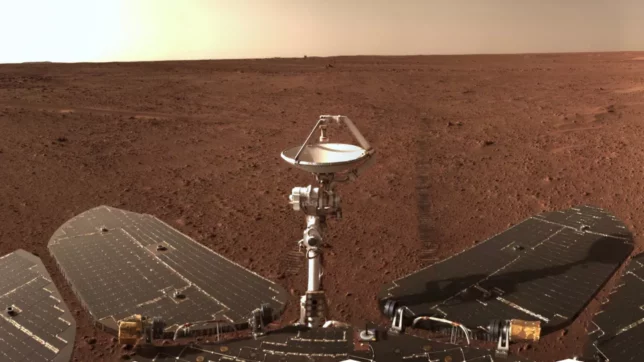
The slide also contains some other interesting information about the orbiter communications. We are already familiar with the nominal and high speed modes.
- Nominal mode: uplink 2000 bps, downlink 16384 bps
- Safe mode: uplink 7.8125 bps, downlink 32 bps
- High speed: 16k – 4096 kbps
The figure below shows how the 1/3 Mars sidereal day orbit looks like in GMAT. The periapsis is close to the equator and the spacecraft descends from north to south during the periapsis passes.

The same orbit in Mars-fixed coordinates looks interesting. The longitude corresponding to the rover location can be seen on the front of the image. We can see that the orbit repeats every 3 revolutions, and that one periapsis pass and one apoapsis pass happen over the rover.
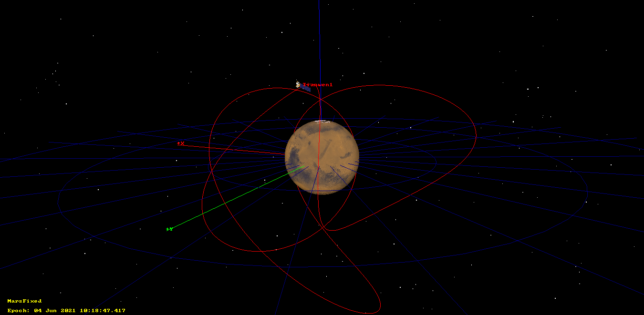
The figure below shows the elevation (blue) and distance (orange) of the orbiter, as seen from Zhurong, during a Mars sidereal day. There are actually three passes per day. The first we see here corresponds to the periapsis pass, which is shown in more detail in another figure below. Then Tianwen-1 is again briefly visible near apoapsis, but it is very low in the sky for practical communications. Finally, we have the apoapsis pass, which lasts around 6 hours, and has distances ranging between 5000 and 14000 km.
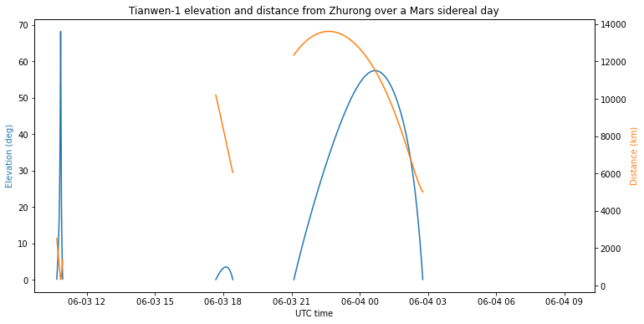
Here we see the periapsis pass. The pass lasts around 15 minutes and the distance ranges between 400 and 2500 km.

In the skyplot we can see that the periapsis pass is almost overhead, going from north to south. The apoapsis pass draws an S-curve shape from south to north.

This kind of orbit was maintained at least until June 3. In that date, the 20 meter antenna at Bochum suffered a failure due to a thunderstorm, and some servos had to be replaced. For this reason, we did not receive any telemetry from Tianwen-1 until September 1, after the antenna was repaired at the end of August. When we checked the new telemetry, we found the spacecraft in a new orbit. We do not know when the orbit change happened.
The new orbit still has a period of 1/3 of a Mars sidereal day. The apoapsis radius is 15854 km, the periapsis altitude is 330 km, and the inclination is 87.0 deg. These are small changes compared to the previous orbit. The remarkable change is the argument of periapsis, which is now 121.8 deg. This places the periapsis further north. The figure below clearly shows the change.
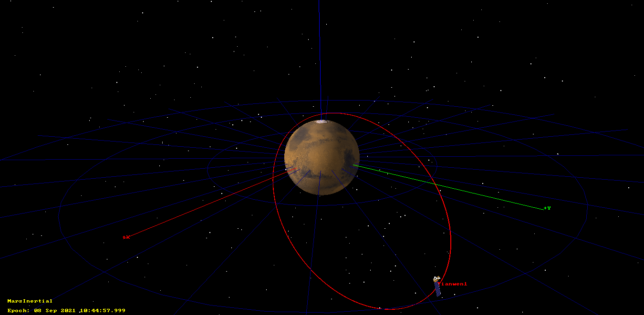
In Mars-fixed coordinates the orbit looks as shown below. The location of the rover is on the front. We can see the spacecraft near the apoapsis pass over the rover, which now is very far south.
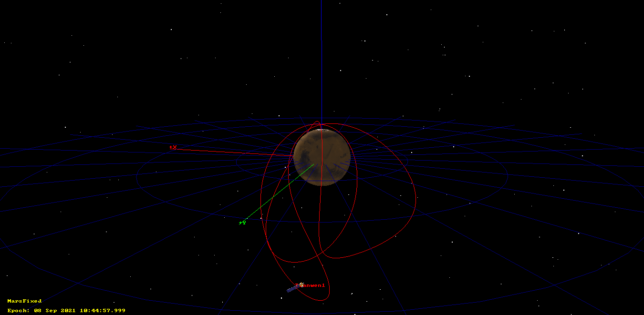
It is interesting to compare the elevation and distance profiles of the orbits in June and September to try to understand the reason why this orbit change was made. Here we see the apoapsis pass at the beginning of the plot. The elevation is much lower, and only reaches 20 deg. The periapsis pass happens near the middle of the plot.
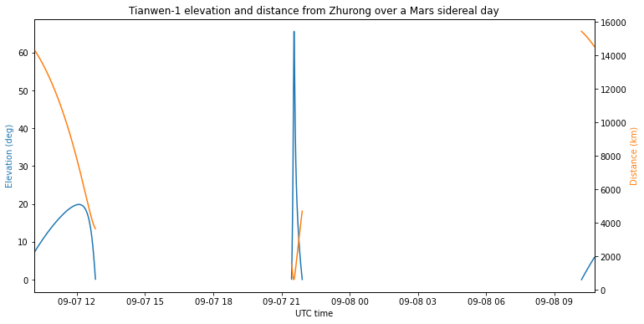
The detailed view at the periapsis pass shows that it is much longer, lasting almost 30 minutes. The distances are also much larger in the second half of the pass. The spacecraft has already passed periapsis and its altitude is increasing, unlike in the June orbit, in which the spacecraft passes periapsis shortly after passing over the rover.
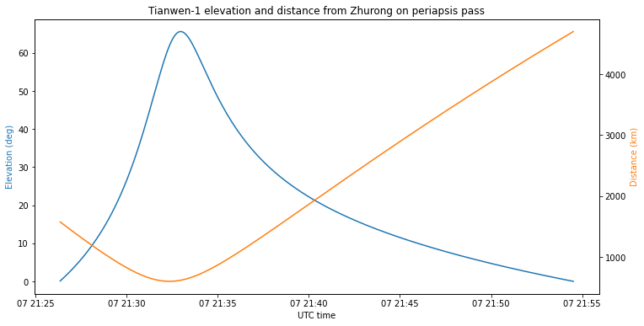
In the skyplot we see that the periapsis pass is still almost overhead. However, the apoapsis pass is a low elevation pass along the south-west.
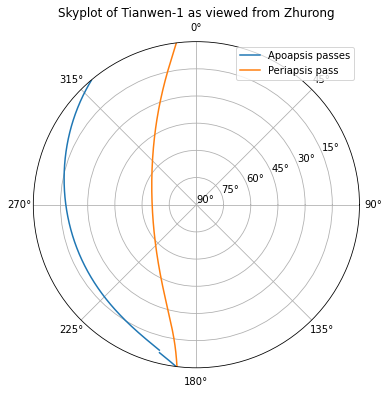
I do not know the reasons motivating this orbit change. Trying to optimize the communications passes with the rover might be one reason. Another reason has to do with the relative position of the sun and the orbital plane. At the beginning of July, the sun passed through the orbital plane, in front of the periapsis. With the original orbit that the spacecraft had in June, this means that the spacecraft would pass through Mars’s shadow during every apoapsis, and spend relatively long periods without sunlight (the spacecraft spends most of its time around apoapsis). By moving the apoapsis south, the shaded area would be crossed some time after apoapsis, and so the spacecraft would take much less time to cross it.
At the beginning of August, the Earth also passed through the orbital plane in front of the periapsis. With the original orbit, from the perspective of Earth the spacecraft would pass relatively long periods behind Mars, impeding communications. This is probably not as problematic as not receiving sunlight, but moving the apoapsis south also helps limit the duration of these communications blockages. In any case, this is just a guess for the reason to change the orbit.
The GMAT script used in this post can be found here. The figures have been made in this Jupyter notebook.